Neuromorphic Chip Market Size
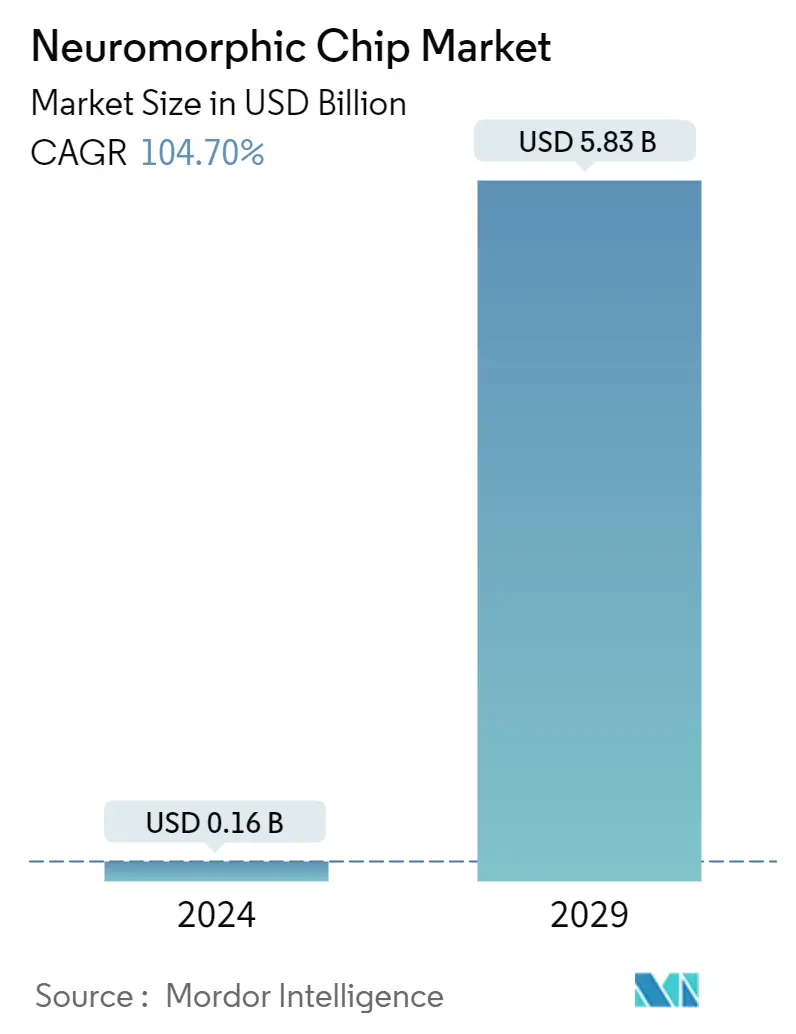
| Study Period | 2019 - 2029 |
| Market Size (2024) | USD 0.16 Billion |
| Market Size (2029) | USD 5.83 Billion |
| CAGR (2024 - 2029) | 104.70 % |
| Fastest Growing Market | Asia-Pacific |
| Largest Market | North America |
Major Players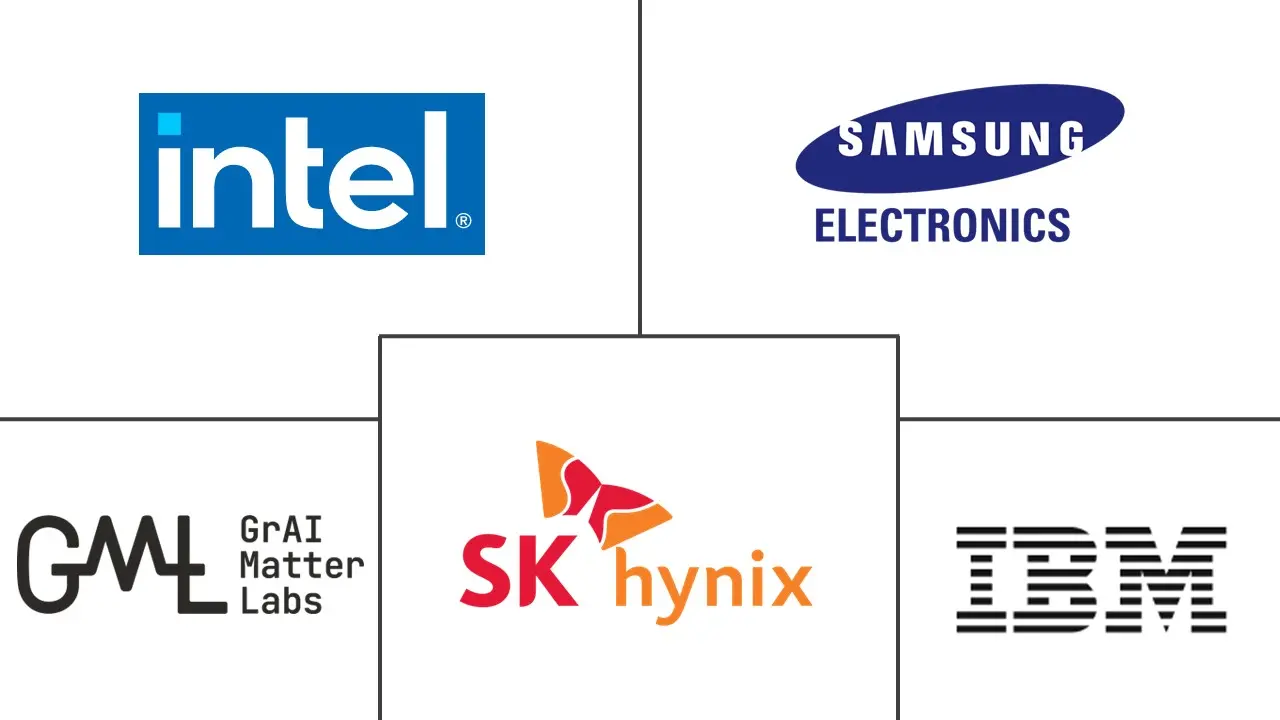
*Disclaimer: Major Players sorted in no particular order |
Need a report that reflects how COVID-19 has impacted this market and its growth?
Neuromorphic Chip Market Analysis
The Neuromorphic Chip Market size is estimated at USD 0.16 billion in 2024, and is expected to reach USD 5.83 billion by 2029, growing at a CAGR of 104.70% during the forecast period (2024-2029).
- The increasing use of biometrics and in-speech recognition drives the demand for neuromorphic chips in smartphones. These chips are used to process audio data in the cloud and then return it to the phone. In addition, Artificial Intelligence (AI) requires more computing power, but low-energy neuromorphic computing could significantly push applications that run presently in the cloud to run directly in the smartphone in the future without substantially draining the phone battery.
- Neuromorphic is a specific brain-inspired ASIC that implements the Spiked Neural Networks (SNNs). It has an object to reach the massively parallel brain processing ability in tens of watts on average. The memory and the processing units are in single abstraction (in-memory computing).
- This leads to the advantage of dynamic, self-programmable behavior in complex environments. Instead of traditional bit-precise computing, neuromorphic hardware leads to the probabilistic models of simple, reliable, robust, and data-efficient computing as the brain's highly stochastic nature. Neuromorphic hardware certainly suits more cognitive applications than precise computing.
- During the next decade, neuromorphic computing will transform the nature and functionalities of a wide range of scientific and non-scientific applications. Some of them include mobile applications that are increasingly demanding powerful processing capacities and abilities.
- The design of neuromorphic chips follows the goal of modeling parts of the biological nervous system. The aim is to reproduce its computational functionality and especially its ability to solve cognitive and perceptual tasks efficiently. Achieving this requires modeling networks of sufficient complexity regarding the number of neurons and synaptic connections. The brain and its ability to learn and adapt to specific problems are still subject to basic neuroscientific research.
- The COVID-19 pandemic had a favorable influence on the medical business market. Several market leaders, including IBM, Hewlett Packard, and Qualcomm, pushed their neuromorphic computing solutions into several hospitals and clinics worldwide. Their technologies' computational skills were able to reduce various difficulties inside a normal hospital ecosystem. The pandemic kept the capital equipment sector humming with a strong demand for next-generation electronics.
Neuromorphic Chip Market Trends
This section covers the major market trends shaping the Neuromorphic Chip Market according to our research experts:
Consumer Electronics Segment Holds Significant Market Share
- The consumer electronics industry identifies neuromorphic computing as a promising tool for enabling high-performance computing and ultra-low power consumption to achieve these goals. For instance, AI services, such as Alexa and Siri, rely on cloud computing with the internet to parse and respond to spoken commands and questions. Neuromorphic chips have the potential to allow several varieties of sensors and devices to perform intelligently without requiring an internet connection.
- Smartphones are expected to be the trigger for the introduction of neuromorphic computing. Several operations, such as biometrics, are power-hungry and data-intensive. For instance, in speech recognition, audio data is processed in the cloud and then returned to the phone.
- Wearable devices are a fast-growing technology with a considerable impact on personal healthcare for both the economy and society. Due to widespread sensors in pervasive and distributed networks, power consumption, processing speed, and system adaptation are vital in the future of smart wearable devices. Additionally, the field of artificial intelligence further boosts the possibility of smart wearable sensory systems. The emerging high-performance systems and intelligent applications need more complexity and demand sensory units to describe the physical object accurately.
- Moreover, increasing the number of wearable devices may further drive market growth. For instance, according to Cisco Systems, the number of connected wearable devices reached 1,105 million in 2022 compared to 929 million in the previous year.
- The increasing interest in neuromorphic engineering shows that hardware-spiking neural networks are considered a critical future technology with high potential in crucial applications, such as edge computing and wearable devices.
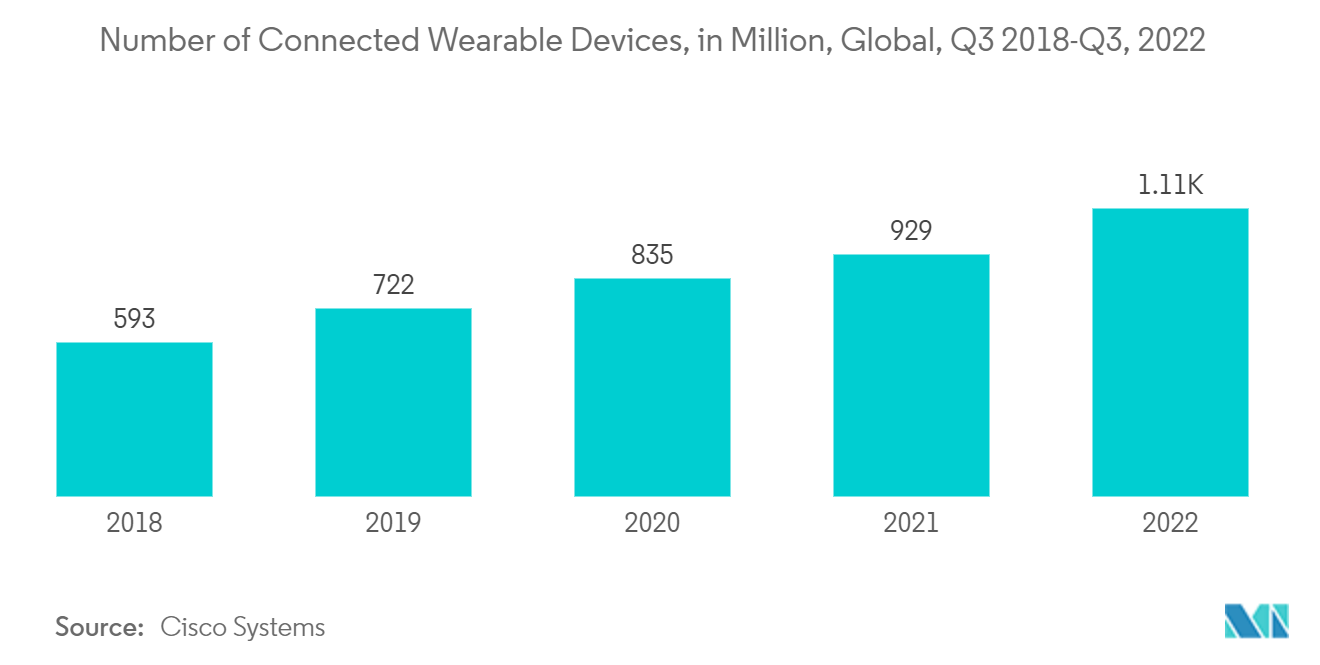
North America to Hold Major Share over the Forecast Period
- North America is home to some of the major market vendors, such as Intel Corporation and IBM Corporation. The market for neuromorphic chips is growing in the region due to factors such as government initiatives, investment activities, and others.
- One of the significant factors behind the growth of the market in North America is the interest shown by government bodies toward neuromorphic computing.
- For instance, in September 2022, the Department of Energy (DOE) announced USD 15 million in funding for 22 research projects to advance neuromorphic computing. The initiative by DOE supports the development of hardware and software for brain-inspired neuromorphic computing.
- On the other hand, the government of Canada is focusing on artificial intelligence technology, which is also expected to create a scope for growth in neuromorphic computing over the coming years. For instance, in June 2022, the Canadian Ministry of Innovation, Science, and Industry announced the start of the second phase of the Pan-Canadian Artificial Intelligence Strategy. The second phase of the strategy is backed by a USD 443 million investment in Budget 2021.
- Several research projects are attracting collaborations for advancements in neuromorphic technology. For instance, in August 2022, the Pritzker School of Molecular Engineering (PME) at the University of Chicago in the United States developed a flexible, stretchable neuromorphic computing chip that processes information by mimicking the human brain. The device intends to alter the way health data is processed.
- There has been growth in AI-based chips in Canada, which is also driving the neuromorphic chips market. For instance, in May 2021, Canadian startup Tenstorrent announced that it had raised USD 200 million and achieved unicorn status. The company had planned to deliver its AI chip for real-world applications in the first half of 2022.
- The increasing defense expenditure of various countries is also expected to drive the demand for neuromorphic computing in North America.
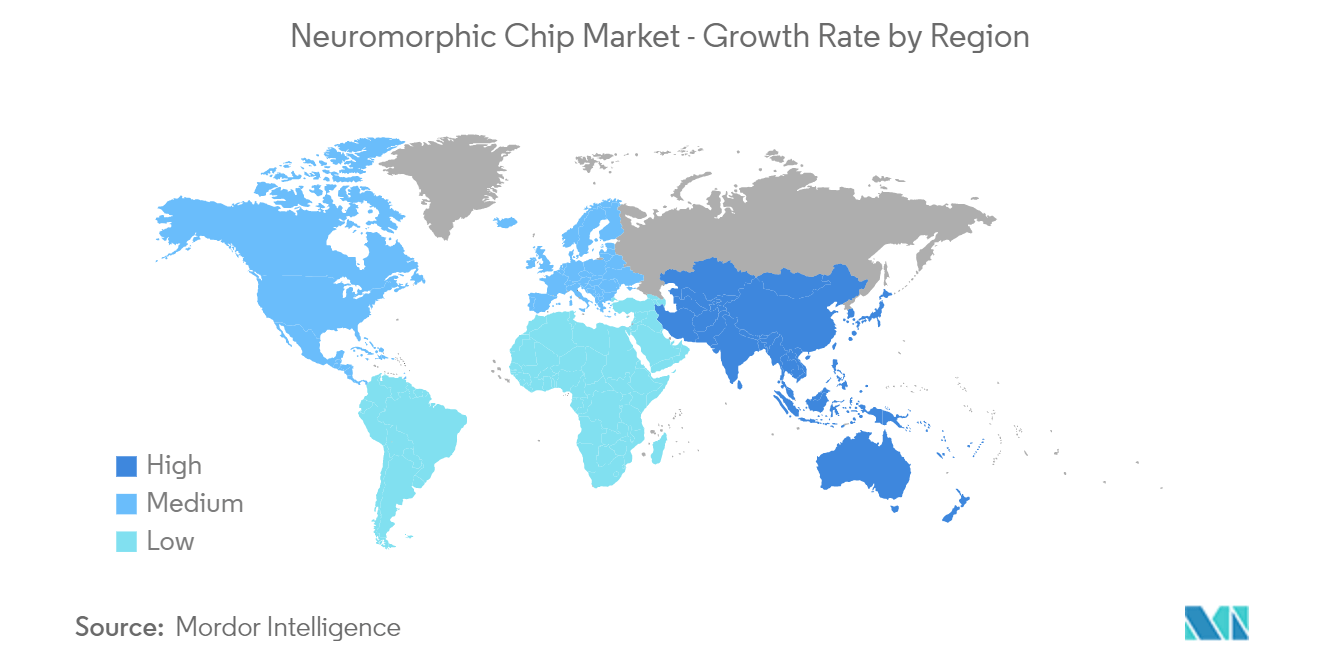
Neuromorphic Chip Industry Overview
The neuromorphic chip market has large-scale semiconductor vendors that command significant revenue generation capabilities, architecture-development start-ups, and universities. The market is consolidated, and vendors are increasingly spending on R&D and collaboration activities to gain technological capabilities and commercialize the market, making the market less competitive.
Despite neuromorphic chips being at an early stage of development, the patent filing activity by players in the market is gaining interest across key semiconductor companies, R&D centers, and universities, and competitive rivalry is poised to increase in the future.
In August 2022, Edge Impulse was launched, which enables developers to create enterprise-grade ML algorithms trained on real-world sensor data in a low-code environment. These trained algorithms can be quantified, optimized, and turned into Spiking Neural Networks (SNN) that are compatible with and deployable with BrainChip Akida devices. This functionality is available for new and existing Edge Impulse projects by utilizing the platform's integrated BrainChip MetaTF model deployment block. This deployment block allows free-tier and enterprise developer users to design and evaluate neuromorphic models for real-world use cases before deploying them on BrainChip Akida development kits.
In April 2022, SynSense announced a collaboration with BMW to advance the integration of neuromorphic chips and smart cockpits. This is the first step in integrating SynSense's brain-like technology into smart cockpits. This neuromorphic technology collaboration with BMW will focus on SynSense's dynamic visual intelligence SoC-Speck, which combines SynSense's low-power SNN vision processor with an event-based sensor on a single chip.
Neuromorphic Chip Market Leaders
Intel Corporation
SK Hynix Inc.
IBM Corporation
Samsung Electronics Co. Ltd
GrAI Matter Labs
*Disclaimer: Major Players sorted in no particular order
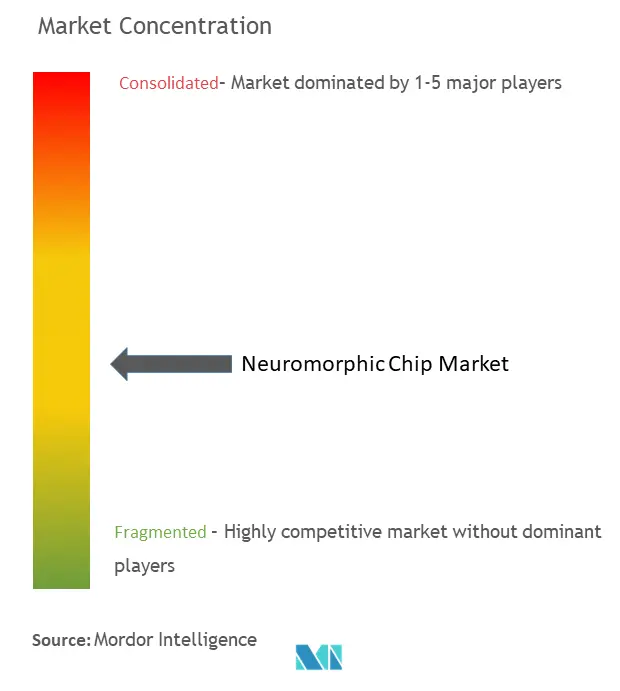
Neuromorphic Chip Market News
- December 2022: Intel launched the latest AI neuromorphic chip to perform data-crunching tasks 1,000 times faster than standard processors like CPUs and GPUs while using much less power. As they are so energy efficient, the technology is ideal for various applications like industrial equipment, cybersecurity, and smart homes.
- November 2022: Oppo announced its collaboration with Qualcomm Technologies in ray tracing graphics for mobile devices. The company planned to implement Google Vertex AI Neural Architecture Search (Google NAS) on a smartphone for the first time. The unique solution concentrates on boosting energy efficiency and latency of AI processing on mobile devices. Further, Oppo claims that its next Find X flagship smartphone will be one of the first to get Qualcomm's latest flagship processor Snapdragon 8 Gen 2 chipset.
- June 2022: China's Tsinghua University Center for Brain-Inspired Computing Research researchers created a neuromorphic chip that consumes less power than a conventional NVIDIA chip designed for AI applications. Tianjicat used slightly more than half the power of an identical NVIDIA chip-based robot. They also discovered that their neuromorphic chip-based robot had 79 times less latency than the NVIDIA-based system, allowing it to make decisions much faster.
Neuromorphic Chip Market Report - Table of Contents
1. INTRODUCTION
1.1 Study Assumptions and Market Definition
1.2 Scope of the Study
2. RESEARCH METHODOLOGY
3. EXECUTIVE SUMMARY
4. MARKET INSIGHTS
4.1 Market Overview
4.2 Industry Attractiveness - Porter Five Forces
4.2.1 Bargaining Power of Suppliers
4.2.2 Bargaining Power of Buyers
4.2.3 Threat of New Entrants
4.2.4 Threat of Substitute Products
4.2.5 Intensity of Competitive Rivalry
4.3 Industry Value Chain Analysis
4.4 Emerging Use Cases for Neuromorphic Chips
4.5 Assessment of the Impact of COVID-19 on the Market
5. MARKET INSIGHTS
5.1 Market Drivers
5.1.1 Increasing Demand for Artificial Intelligence-based Microchips
5.1.2 Emerging Trend of Combining the Concept of Neuroplasticity with Electronics
5.2 Market Challenges
5.2.1 Need for High Level of Precision and Complexity in Hardware Design
6. GLOBAL DEEP LEARNING MARKET ANALYSIS
6.1 Current market scenario
6.2 Global Deep Learning Market Segmentation
6.2.1 By Type
6.2.1.1 CPU
6.2.1.2 GPU
6.2.1.3 FPGA
6.2.1.4 ASIC
6.2.1.5 SoC Accelerators
6.3 Coverage on the Current Trends in the Deep Learning Software and Service industry
6.4 Investment Scenario
6.5 List of Major Hardware Vendors
6.6 Future of the Market
7. MARKET SEGMENTATION
7.1 By End-User Industry
7.1.1 Financial Services and Cybersecurity
7.1.2 Automotive (ADAS/Autonomous Vehicles)
7.1.3 Industrial (IoT Ecosystem, Surveillance, and Robotics)
7.1.4 Consumer Electronics
7.1.5 Other End-user Industries (Medical, Space, Defense, Etc.)
7.2 By Geography
7.2.1 North America
7.2.2 Europe
7.2.3 Asia Pacific
7.2.4 Rest of the World
8. COMPETITIVE LANDSCAPE
8.1 Company Profiles
8.1.1 Intel Corporation
8.1.2 SK Hynix Inc.
8.1.3 IBM Corporation
8.1.4 Samsung Electronics Co. Ltd
8.1.5 GrAI Matter Labs
8.1.6 Nepes Corporation
8.1.7 General Vision Inc.
8.1.8 Gyrfalcon Technology Inc.
8.1.9 BrainChip Holdings Ltd
8.1.10 Vicarious FPC Inc.
8.1.11 SynSense AG
- *List Not Exhaustive
9. INVESTMENT ANALYSIS
10. FUTURE OF THE MARKET
Neuromorphic Chip Industry Segmentation
Neuromorphic chips are digitally-processed analog chips with a series of networks similar to human brain networks. These chips contain millions of neurons and synapses to augment self-intelligence, irrespective of pre-installed codes in normal chips. As a special kind of chip, neuromorphic chips can manipulate data received through sensors. For the purpose of the study, chips that adopt the SNN approach have been considered as part of the scope. The market studied tracks deep learning hardware and neuromorphic chips as separate markets.
The market size for the neuromorphic chip is evaluated by analyzing the market sizes of different market players operating in the market across different end-user industries, such as financial services and cybersecurity, automotive, industrial, and consumer electronics in multiple geographies, including North America, Europe, Asia Pacific, and the Rest of the World. Only computing and sensing applications of neuromorphic chips were considered for the market study. The competitive landscape has been taken to calculate the penetration of neuromorphic chips and how players involve themselves in organic and inorganic growth strategies. In addition, these companies continuously innovate their products to increase their market share and profitability. Further, the market study has also focused on the impact of the COVID-19 pandemic on the market ecosystem. The market sizes and forecasts are provided in terms of value in USD million for all the above segments.
| By End-User Industry | |
| Financial Services and Cybersecurity | |
| Automotive (ADAS/Autonomous Vehicles) | |
| Industrial (IoT Ecosystem, Surveillance, and Robotics) | |
| Consumer Electronics | |
| Other End-user Industries (Medical, Space, Defense, Etc.) |
| By Geography | |
| North America | |
| Europe | |
| Asia Pacific | |
| Rest of the World |
Neuromorphic Chip Market Research FAQs
How big is the Neuromorphic Chip Market?
The Neuromorphic Chip Market size is expected to reach USD 0.16 billion in 2024 and grow at a CAGR of 104.70% to reach USD 5.83 billion by 2029.
What is the current Neuromorphic Chip Market size?
In 2024, the Neuromorphic Chip Market size is expected to reach USD 0.16 billion.
Who are the key players in Neuromorphic Chip Market?
Intel Corporation, SK Hynix Inc., IBM Corporation, Samsung Electronics Co. Ltd and GrAI Matter Labs are the major companies operating in the Neuromorphic Chip Market.
Which is the fastest growing region in Neuromorphic Chip Market?
Asia-Pacific is estimated to grow at the highest CAGR over the forecast period (2024-2029).
Which region has the biggest share in Neuromorphic Chip Market?
In 2024, the North America accounts for the largest market share in Neuromorphic Chip Market.
What years does this Neuromorphic Chip Market cover, and what was the market size in 2023?
In 2023, the Neuromorphic Chip Market size was estimated at USD 0.08 billion. The report covers the Neuromorphic Chip Market historical market size for years: 2019, 2020, 2021, 2022 and 2023. The report also forecasts the Neuromorphic Chip Market size for years: 2024, 2025, 2026, 2027, 2028 and 2029.
Neuromorphic Chip Industry Report
Statistics for the 2024 Neuromorphic Chip market share, size and revenue growth rate, created by Mordor Intelligence™ Industry Reports. Neuromorphic Chip analysis includes a market forecast outlook to 2029 and historical overview. Get a sample of this industry analysis as a free report PDF download.
